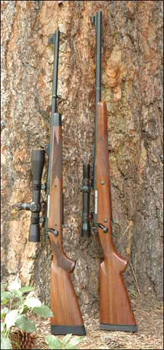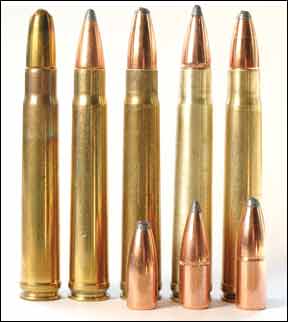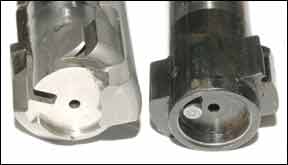Some time back a reader asked us which 375 H&H Magnum rifle we’d suggest for his son, who was going to Africa for an extended hunt. He wanted to know if the current crop of Winchesters and Remingtons were any good in that caliber, and which one we’d recommend for his son. We knew Winchester was producing a new Model 70 Winchester, made by FN in the U.S., but had examined only a Lightweight Compact 308 Model 70. We thought it was a pretty good rifle, but those who can make a good 308 cannot necessarily make a good 375. We knew Remington used to make a decent 375, and a quick search of the Remington website showed us a current offering in that caliber. We acquired a new Model 70 Winchester (MSRP $1400) and a new Remington 700 CDL 375 100th Anniversary Edition. (MSRP $1450) and put them to the test. We tested with Hornady Heavy Magnum 300-grain FMJ RN solids and 270-grain Hornady Heavy Magnum SP InterLock, and with handloads using 235-grain Speer Semi-Spitzer Hot Core, 270-grain Hornady Spire-Point, and 300-grain Nosler Partition bullets. Here are our findings.

Winchester Model 70 Safari Express
375 H&H Magnum, $1420
Our first touch of this big rifle told us it was less than graceful. The stock felt clumsy to us and the rifle felt dead in our hands. The stock was too big at the wrist, reminding us of a CZ 416 Rigby 550 American we recently examined. The Winchester was heavy, 9.2 pounds with no scope. The wood was decent-quality walnut, nicely finished, checkered, and inletted with the exception of the barrel, which was free floated. The all-steel metalwork was well finished with matte bluing.
The barrel was a mid-weight one of 24 inch length. Despite the declaration by Winchester that this barrel was hammer forged, we saw evidence of chatter or other marks at the muzzle on top of the lands and in the bottom of the grooves. These marks seemed to be gathering lots of bullet metal and it was hard to get the barrel clean. Accordingly we fire-lapped it with the NECO system a few rounds to clean it up, and that seemed to help us get the barrel clean as we proceeded.
The recoil pad was a well-fitted black Pachmayr Decelerator an inch thick. It worked well for us. The stock had no cast off, but did have a cheekpiece that kept the kick off our face. The forend checkering wrapped the stock in a generous panel, and the wrist had two swatches that had a curved rear-border design that left some of us cold. There was no pistol-grip cap nor forend tip. The rear sling swivel was a nicely inletted one similar to those seen on prewar Super Grades. The two big anti-cracking bolts transversing the stock brought back the old look of earlier M70 375s, but in this case the bolts were loose when the rifle arrived. Happily we didn’t need the old two-pronged special tool to tighten ‘em. They were Allen screws, like the action screws, and so were easy to get tight. Speaking of the action screws, Winchester put the correct torque for them in the owner’s manual, one of the first times we’ve seen that. The forend sling swivel was on the barrel where it belongs on hard-kicking rifles that are not likely to be shot with the use of a sling.
The rifle was fitted with iron sights, and that’s where our first troubles began. The rear sight was an ongoing horror that originated long ago on some Model 70 375s. There’s a U-notch at the bottom of the otherwise lovely wide-angle V rear sight. Winchester has on occasion put a proper V sight on its 375s, essentially a good English-type express sight which when mated with a front bead or, much better, Sourdough front blade, gives excellent control of windage and elevation and is as fast as lightning to use on close targets. Where this U-notch comes from escapes us. A holdover from the ungodly buckhorn sight of yore, it’s useless, or so most of us thought. We did like the front hood, which will keep the front sight from harm. We also liked the big flat-faced brass bead.

Every time we picked up the rifle by its forend, the stock would creak like it was going to break. There was no support between the forend and the free-floated barrel, which permitted slight motion and gave the creaking sound. This does not give confidence. We’d glass-bed this rifle in a heartbeat if we owned it, and would consider a third action screw through the forend into the base of the front sight, as in days of yore (and still done by CZ today). Gone is the third screw under the floorplate at the front of the trigger guard, as on previous Model 70s.
The good stuff was that the metal work was some of the finest we’ve seen on Winchester Model 70s of any vintage. Some of the parts, like the bolt handle, were castings, but all the critical parts were well machined and well fitted. This was a controlled-feed rifle, and it even retained the old cone-shaped breech of the original M70. The bolt takedown was just the same: put the safety on half way, remove the bolt, push the button and unscrew the striker assembly. The threads there are finer, so it takes lots more spinning to get it apart. The bolt motion is mighty slick with the help of a small hook on the bolt under the right locking lug. So the bolt doesn’t need the old anti-binding bump of long ago. The trigger is a new system, which leaves a large opening in the bottom of the trigger plate, which we don’t like. The old M70 trigger was one of the finest ever made, simple to adjust and very reliable. The new system does give a great pull but we don’t think it’s any better than the old one. The hinged floor plate has its open-up button in the same place, outside the guard and out of the way. It’s easier to open than on older M70s.
The Winchester Model 70 had some glitches. Normally, you load a rifle’s magazine by shoving a fresh cartridge into the opening, then slide it fully rearward, and press down. The cartridge then slips into the magazine as far back as it can go, where it belongs. When we tried that with this rifle, the rear of the cartridge hung up on the rear of the action because the ejector, which controls how far rearward the incoming round can be shoved back, is too short. The cartridge goes too far back and fouls on the action abutment, so it can’t go down into place until it is moved forward about a sixteenth of an inch. That’s not easy if you’re in a hurry. This is not what you want on a rifle that may be taken against dangerous game, or even on your next elk hunt. We feel that a rifle costing $1400 ought to have everything absolutely right about it. This one didn’t.
One the range we shot a few with the iron sights at 100 yards. We made a group of under 2 inches, but it was a foot high. The rear sight was down as low as it would go, yet the shots hit way high. If the U-notch in the wide V were filled in the shots would be higher yet. The front sight needs to be higher, so there’s added expense to an already costly rifle. This ought to have been tested by the factory.

We mounted a classic old Weaver (El Paso) 2.5x steel-tube scope with post and crosshair. It had a matte finish that looked great with this rifle, we thought. Many years ago Tech Editor Ray Ordorica came up with a 375-Winchester testing load using a modest charge of IMR 4895 behind Speer’s 235-grain Semi-Spitzer. Sure enough, the Winchester put three of ‘em into 0.7 inch at 100 yards, and three more into 0.9 inch. However, one round failed to fire. It fired the second time we tried it. Later in our test series we had a failure to fire with Hornady factory ammo, and then another failure with different ammo. Despite the Winchester’s being able to shoot well with most of our test ammo, we lost faith in it because of these failures. We checked the striker and inside the bolt, but found nothing obviously wrong. The rifle fired 99 percent of the time, but that’s not good enough. We would check the headspace on this rifle before we bought it. If Winchester gave it to us we’d still check headspace, and if that was okay we’d put a new striker spring in it, or perhaps a longer firing pin. We’d also put in a longer ejector to fix the problem with loading the magazine.
Our Team Said: We would not buy this rifle for an African hunt, not even for non-dangerous game. It did not have the graceful balance of our older CZ, nor did it hold five rounds as did the CZ, though its accuracy was good enough. Missing were the little details that make up a great rifle. Problems include the balky-loading magazine, the useless and too-high iron sights, the lead-like feel, and the occasional failures to fire. These made us downgrade this rifle to a C+. It had fine metalwork, smooth feeding and ejection, some really nice touches here and there, great metal and wood finish, and was in many ways one of the better iterations of the Model 70s of all time. But it wasn’t quite right, our testers believed.
Remington Model 700 CDL 375
100th Anniversary Edition, $1450
The Remington was a mighty attractive rifle. Its name commemorates the 100th anniversary of the cartridge, not the rifle. The wood and metal finish were excellent. The first thing we noted was the light weight of the rifle, 7.2 pounds with no scope. The stock had a recoil pad that was 1.5 inches thick. That was comforting, given the light weight of the rifle. The stock was of a nice shape and size, with a slim wrist and graceful forend. Unfortunately, part of the inletting was botched. We found a terrible fit of the stock to the magazine at the bottom. The magazine box, generally invisible from outside the rifle, stuck out like a sore thumb on the left side, but was properly covered by the stock on the other. The forend had a black tip made of something other than ebony, we suspect, given the recent rabid act of the U.S. Fish & Wildlife Service confiscating Gibson Guitars’ ebony. Will they steal your Remington if it has a genuine ebony forend tip? This rifle also had a black cap on the pistol grip.
Some of us here don’t like contrasting forend tips because the different expansion rates can cause them to come off or crack over time. But while we prefer wood stocks that are all one piece of wood, we admit Remington did a fine job of making this forend look mighty good. The checkering, just slightly darker than the rest of the matte-finished wood, wrapped around the forend. The wrist, like that of the Winchester, had odd curves to its border that again left us cold. The rest of the rifle was standard Remington 700: round action, recoil plate between barrel and action, recessed bolt face with hidden extractor, flattened and checkered bolt handle, two cross pins for added stock security, and a free-floated barrel. The wood was decent walnut, though kind of plain, we thought, for a CDL-grade Remington. Yet the grain through the slim wrist looked just right.
The forward sling swivel is stuck onto the barrel as an afterthought, much like an amateur gunsmith might do when he forgets to attach a barrel-band front swivel, blues the gun, and then realizes he’s forgotten something. Its bluing didn’t match the rest of the rifle. The rear iron sight was the exact same monstrosity put on the Winchester, a nice wide V with a huge U-notch in the bottom. English express sights are not buckhorns, as Remington and Winchester seem to think. They don’t want or need a U-notch at the bottom, but they do need an easily seen vertical line at the center for proper use. This and the identical sight on the Winchester didn’t have the central line. The front sight was a small bead on a ramp, with a small hood protecting it. It was high enough that it was possible to sight-in the rifle with the irons before mounting a scope. To our surprise, the Remington was quite comfortable to shoot with no scope mounted, thanks to that thick pad. Ruger take note!
We put on our heaviest scope, a Mark 4 Leupold 16×40, to compensate for the light weight of the rifle. That got the weight up to 8.8 pounds empty. At that weight we found the Remington to be comfortable from the bench. We were going to condemn the Remington for its light weight, but there are hunting situations that require climbing at high altitudes, which calls for a light rifle, yet the rifle may still need lots of power. Also, if the shooter knows how to handle recoil, he’s more likely to choose this light yet powerful rifle over a lesser one, and do the game he hunts a big favor by so doing. For conditions like that, this Remington comes into its own.
Remington has a new trigger called the X-Mark Pro that gives the shooter the option of external adjustment. The trigger adjustment is a sharp, protruding screw high on the trigger where the trigger finger, bouncing around during recoil of this big, light rifle, can get cut by it. The pull was 3.7 pounds clean. Also inside the trigger guard is what we thought was another mistake, but it fooled us. The magazine floor-plate release was located high inside the guard. It required only a light tap to release all the rounds from the magazine. We were quite sure our finger would hit it in recoil, but we were lucky and that didn’t happen. We still suspect it’ll open for someone, and will do so at the worst possible time.
On the range we didn’t like the difficulty of getting rounds into the magazine. They bound up at the back much like with the Winchester. It required some work to get each round under the rails. But once they were there, they fed and fired and ejected without any problems. However, we also found a stunning lack of accuracy. Our very best group was 1.4 inches for three of Hornady’s Heavy Mag 300-grain solids. These averaged 2.1 inches, which in fairness was better than they did out of the Winchester, which averaged 4 inches with these hot loads. They came out at around 2600 fps, and as we found in previous 375 tests, loads that give the old maximum velocity of 2500 fps with 300-grain bullets shoot generally better than the modern higher-speed ones. Neither did the Remington like our light test load with the 235-grain Speer, though it did give the second-best average groups with this rifle of 2.5 inches.
Our Team Said: We had mixed feelings about this rifle. We didn’t like its accuracy, but that could perhaps be fixed by glass bedding. The feed, firing, ejection, and trigger pull were fine, as were the iron sights for being able to be zeroed. The stock fit around the magazine was probable cause for rejection by the factory, because there is no fixing it. The metal finish, stock work and finish, inletting and checkering were all well done. If the accuracy could be fixed, we’d give this a higher grade, but as it is, with its slipshod work on the magazine fitting, we probably wouldn’t buy it. If we had to pick one, we’d of course choose the Remington because it always fired. The Remington was, we thought, possibly useful for African use on non-dangerous game. But its workmanship condemned it for use on dangerous game because for that use you need to have confidence in your rifle, and this improper fitting just destroys confidence in the thing. If we can see something that’s not right, what else is wrong that we can’t see? Instead, we’d take a CZ or maybe a Ruger in its 375 Ruger caliber, but in all cases we would test and retest everything about any serious rifle before leaving town.
0912-RIFLE-ACC-AND-CHRONO-DATA.pdf
0912-WINCHESTER-MODEL-70-SAFARI.pdf





























